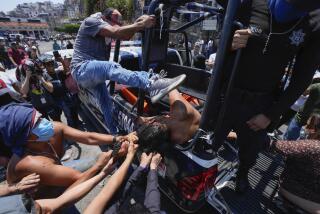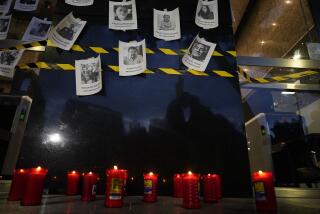The fate of earthquake victim ‘Frida Sofia’ captivated Mexico. But it seems she never existed

The secretary of education said authorities had been unable to locate any parents of a girl named Frida Sofia. (Sept. 22, 2017)
As rescue efforts enter a third day, Mexicans have been captivated by the fate of earthquake victim “Frida Sofia,” a young girl supposedly trapped under the collapsed Enrique Rebsamen school in Mexico City.
But even as Frida Sofia gained fame around the world, her story quickly began to fall apart.
Government officials never confirmed the identity of such a child. No student was registered at the school under that name, they insisted.
The secretary of education on Thursday also said authorities had been unable to locate any parents of a girl identified in widespread Mexican media reports as the 12-year-old Frida Sofia.
And on Thursday afternoon, the Mexican navy reported that there were no signs that a child was still alive in the wreckage of the three-story school building that was turned into a mound of concrete rubble by Tuesday’s magnitude 7.1 earthquake.
“All of the children are, unfortunately, dead or safe at home,” said Angel Enrique Sarmiento, the undersecretary of the navy. In fact, he said, government authorities were never aware of the existence of any child named Frida Sofia.
The confusing Frida Sofia saga took another strange turn Thursday night, when a grim-faced Sarmiento went on live television and sought to explain earlier statements by the navy about the girl. He ended up confusing matters even further.
Earlier Thursday, Sarmiento had insisted that the navy never had any knowledge of a girl who was supposedly trapped in the rubble.
In his evening news conference, however, Sarmiento contradicted the earlier statement, conceding that the navy had distributed reports of a girl surviving inside the school “based on technical reports and the testimony of civilian rescue workers and of this institution.” He offered no explanation for the conflicting accounts, but apologized.
“I offer an apology to Mexicans for the information given this afternoon in which I said that the navy did not have any details about a supposed minor survivor in this tragedy,” Sarmiento, dressed in military fatigues, told reporters at an outdoor news conference.
Sarmiento repeated his earlier assertion that it was possible that someone remained alive in the rubble. But Thursday evening he did not rule out the possibility that it was a child. Mexicans and others following the matter were left perplexed.
“Nonetheless,” Sarmiento added, “the Mexican people should know that as long as the minimum possibility exists that there is someone alive, we will keep on looking with the same determination.”
Both he and a colleague, Maj. Jose Luis Vergara, denied any effort to mislead the public.
Hope that a child was still alive at the school had energized emergency crews and volunteers who have extracted more than 20 bodies, mostly those of children, from the collapsed structure.
The story of the missing girl had inspired the hashtag #FridaSofia, which trended on Twitter. Mexicans captivated by the story shared it as a beacon of optimism and hope across social media.
Much of the story appeared to originate from reporters for the Televisa network. They said on social media that the girl told rescue workers that she was with five other classmates.
News that there apparently was no living girl under the rubble prompted a new social media eruption, this one of outrage.
“Fake news,” many people tweeted.
“State-run media failed hoax,” said one Twitter user. “Distracted [international] community for at least 72 hours.”
For some Mexicans, the ghostly saga of Frida Sofia was reminiscent of the attempted rescue tale of Luis “Monchito” Navarrete, a 9-year-old boy who was believed to be buried with his grandfather under the rubble of an apartment building after the magnitude 8.1 earthquake that hit Mexico City in 1985.
According to news stories from the time, rescue workers spent more than two weeks trying to rescue the boy and his grandfather after apparently communicating with the boy.
Hope rose and fell for the boy’s parents, who kept a vigil in the street, especially as workers alternately said they had spoken to the boy, then recanted their story.
In the end, the grandfather’s body was extracted from the building, but not the boy’s.
Twitter: @latvives
Twitter: @mcdneville
Vives reported from Los Angeles and McDonnell from Mexico City.
Cecilia Sanchez of the Mexico City bureau contributed to this report.
ALSO
Mexicans aren’t counting on the government to rescue them. They’re saving themselves
UPDATES:
9:50 p.m.: This article was updated with additional comments by Angel Enrique Sarmiento.
4:35 p.m.: This article was updated with information about a previous unsuccessful rescue attempt.
3:40 p.m.: This article was updated with background about a 1985 rescue effort.
1:40 p.m.: This article was updated with confirmation from authorities that no children are believed to be alive in the rubble of the school.
1:00 p.m.: This article was updated with additional details from school authorities about the student.
This article was originally published at 10:25 a.m.
More to Read
Start your day right
Sign up for Essential California for news, features and recommendations from the L.A. Times and beyond in your inbox six days a week.
You may occasionally receive promotional content from the Los Angeles Times.







